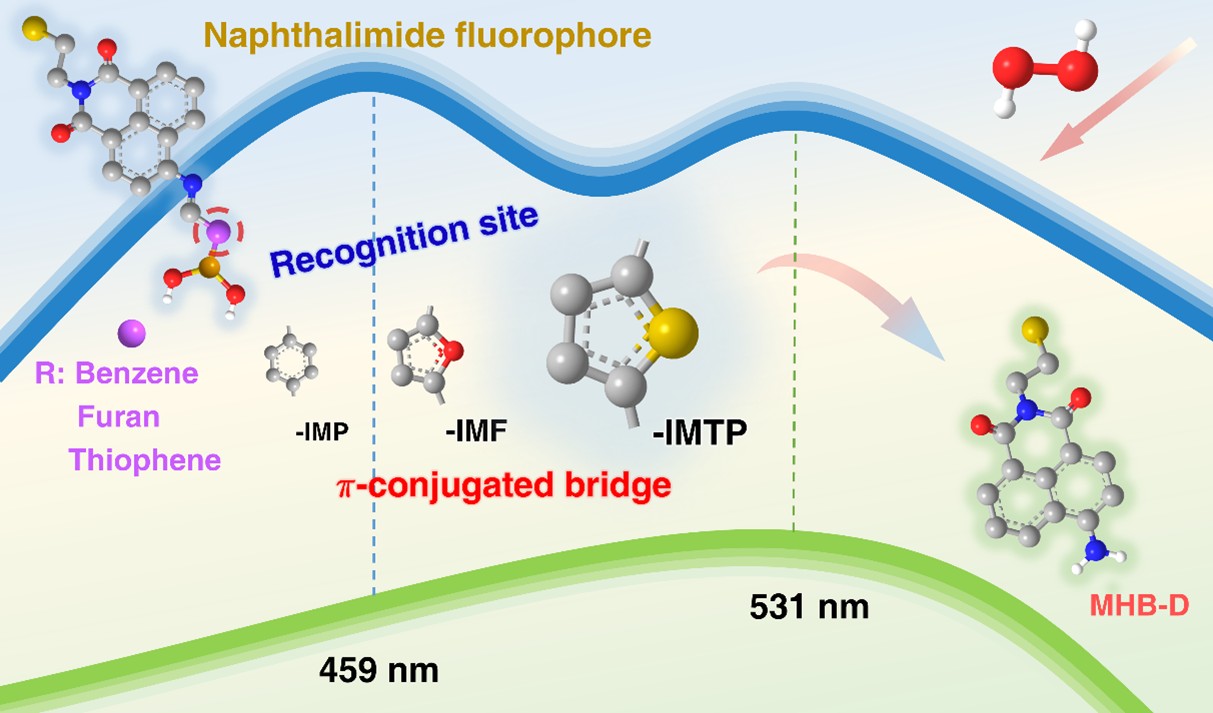Progress in the π Conjugated Bridge Regulation Strategy of Naphthalimide-Based Probes for High-Performance Fluorescent Sensing of H2O2
Editor: | Jun 11,2025
The highly sensitive detection of improvised explosives is of great significance for ensuring national security and public safety, yet remains a major challenge in analytical detection. Xinjiang Key Laboratory of Trace Chemical Substances Sensing, Xinjiang Technical Institute of Physics and Chemistry, Chinese Academy of Sciences, has dedicated extensive research to enhancing on-site trace explosives detection performance through fundamental mechanism studies. The laboratory has pioneered a series of solutions to boost the detection sensitivity and anti-interference capabilities in aspects such as modulating fluorescent probe structure, tuning amorphous nanomaterial, and constructing multimodal sensing materials (Angew. Chem. Int. Ed. 2022, 61, e202203358; Adv. Mater. 2023, 35, 2300526; Adv. Mater. 2020, 32, 1907043; Adv. Sci. 2024, 11, 2309182; JACS Au, 2024, 4, 545; Aggregate 2022, 3, e260).
Hydrogen peroxide (H2O2), the primary precursor for representative improvised explosives—including triacetone-triperoxide (TATP), diacetone diperoxide (DADP), and hexamethylene triperoxide diamine (HMTD)—demands ultrasensitive detection performance to meet the requirement in practical scenarios. To address this challenge, Xinjiang Key Laboratory of Trace Chemical Substances Sensing has proposed a synergistic strategy to improve the detection sensitivity towards H2O2 via π conjugated bridge regulation and nanocellulose signal enrichment. Firstly, thiophene, benzene ring and furan were successfully introduced as the bridge, and three naphthalimide-based probes (MOHB-IMTP, MOHB-IMP, and MOHB-IMF) featuring boric acid as the recognition site were designed and synthesized. Among these, the MOHB-IMTP probe demonstrated the strongest reactivity, while H2O2 detection triggers the oxidation of its boric acid and the cleavage of the π-conjugated bridge’s C=N bond, resulting in a ratiometric fluorescent change from light blue to yellow-green. This MOHB-IMTP probe showed superior sensing performance toward H2O2, including a lower LOD (38.5 nM) and an excellent selectivity even in the existence of 22 interferents. Secondly, further signal enrichment for an even better LOD of 4.0 nM was realized through a MOHB-IMTP/cellulose colloidal probe, which enabled successful integration into a portable device for automated monitoring. The synergistic π conjugated bridge regulation and nanocellulose signal enrichment strategies are expected to provide new ideas for the design of highly sensitive sensing materials against trace chemical substances.
This progress was published in Analytical Chemistry entitled as "Precise Modulation of the π-Conjugated Bridge of Naphthalimide-Based Probes for High-Performance Fluorescent Sensing of H2O2". This work was supported by the National Natural Science Foundation of China, the Natural Science Foundation of Xinjiang, the Tianshan Innovation Team Plan, and the Youth Innovation Promotion Association of the Chinese Academy of Sciences.

Figure: Schematic Diagram of π Conjugated Bridge Regulation Strategy for Naphthalimide-Based Fluorescent Probes
附件下载:
 (86) 991-3838931
(86) 991-3838931 lhskj@ms.xjb.ac.cn
lhskj@ms.xjb.ac.cn (86)991-3838957
(86)991-3838957 40-1 Beijing Road
Urumqi, XinjiangChina
40-1 Beijing Road
Urumqi, XinjiangChina